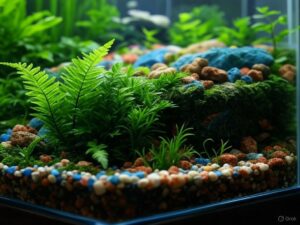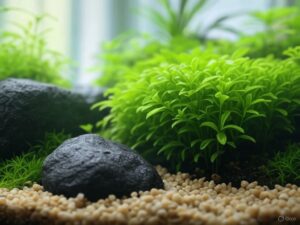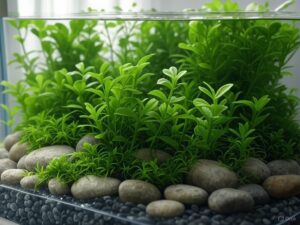Essential Strategies for Mastering Aquascaping and Avoiding Common Mistakes
Aquascaping for Beginners involves envisioning a stunning underwater world, akin to a miniature forest, where the elements of water, plants, and rocks converge in a breathtaking showcase. This art form transforms an ordinary aquarium into a spectacular aquatic landscape, merging creativity with scientific principles to produce an enchanting visual environment. Engaging in this fulfilling hobby not only enhances the aesthetic appeal of your home or office but also nurtures a serene atmosphere that can provide mental relaxation. With the right techniques and understanding, anyone can design a captivating aquascape that serves as a striking focal point and conversation starter.
The adventure in aquascaping begins with the careful selection of the right tank size, which serves as a critical first step in your journey. Opting for a tank that is too small can hinder your ability to realize your design vision effectively, while choosing one that is excessively large may lead to daunting maintenance challenges. Assess your available space thoughtfully, considering how the tank will harmonize with the overall decor of the room, ensuring it complements the existing aesthetic while creating a tranquil and inviting atmosphere.
Establishing a clear vision for your desired aquascape setup is imperative. Are you striving for a visually stunning centerpiece or a practical, low-maintenance aquatic environment? This vision will guide your choices in selecting the ideal plants, rocks, and fish that align with your overall objectives. Take into account both the practical functionality and the beauty of each element, ensuring they harmonize together to achieve your desired aesthetic outcome.
For beginners venturing into aquascaping, an invaluable tip is to start with straightforward designs. Although intricate layouts may catch the eye, they can present significant challenges for those new to the craft. Dedicate time to learn the basics, such as understanding how different plants and rocks interact within the ecosystem, before advancing to more elaborate designs. Mastering foundational skills will bolster your confidence and creativity as you progress in your aquascaping journey.
Grasping the essential principles of aquascaping is crucial for steering clear of common mistakes. With careful planning and a touch of creativity, you can metamorphose any ordinary aquarium into a captivating masterpiece that enchants viewers and brings joy to your living space.

Strategic Approaches to Avoiding Substrate Selection Mistakes in Your Aquascape
The term “substrate” refers to the foundational material that forms the base layer of your aquarium, and while it may sound technical, it’s a vital component in your aquascape.
Think of the substrate as the bedrock upon which your entire aquatic paradise flourishes. It significantly impacts the health of your plants, their growth, and the overall aesthetic appeal of your tank. Choosing the right substrate can greatly enhance the vitality of your plants and the equilibrium of your ecosystem.
Employing an inappropriate substrate can disrupt the balance of your entire aquascaping design. Have you ever noticed an aquarium that looks cluttered or chaotic? Frequently, the problem arises from poor substrate choices. Choose nutrient-rich substrates that provide essential support for plant growth, akin to supplying your plants with a diet enriched with superfoods to help them thrive.
When selecting your substrate, resist the urge to prioritize aesthetics alone. Although it may appear attractive, if it fails to meet the biological needs of your plants, you’ll end up with a tank that is visually appealing but ultimately ineffective. Consider layering different substrate types to create a visually stunning yet functional base for your aquascape.
Regarding layout, while a seemingly random arrangement may appear visually dynamic, it often results in a chaotic look within the tank.
Design your aquascape with purpose and intention. Have a well-thought-out plan for the arrangement of each element and stick to it for a cohesive appearance. A well-structured layout not only enhances visual appeal but also contributes to the overall harmony and balance of your aquarium.
Keep in mind that perspective is key in aquascaping. You want to avoid crafting a tank that seems flat or two-dimensional. By incorporating varying heights and depths using rocks, driftwood, and plants, you can create a more dynamic and realistic environment that captivates viewers and evokes a sense of wonder.
Be aware that the arrangement of your aquascape can significantly impact its overall success or failure.

Effective Plant Selection and Maintenance Strategies for a Flourishing Aquatic Ecosystem
Choosing the right plants for your aquascape is not just about aesthetics; it’s akin to designing a miniature garden where each species must complement one another. The objective is to ensure that the plants grow in harmony, rather than competing for space or light, thereby creating a cohesive and flourishing environment.
As you embark on your aquascaping journey, the vast array of plant options can be daunting. It’s easy to become overly ambitious and overcrowd your tank, resulting in a chaotic and jungle-like atmosphere. Remember that providing adequate space for each plant allows them to thrive individually while fostering a healthier aquatic ecosystem. In this regard, space is your ally in nurturing a balanced and thriving habitat.
Lighting is another critical factor influencing your plants’ health. Just as with terrestrial gardens, different aquatic plants have unique light requirements. Excessive light can lead to bleaching in some plants, while inadequate lighting can stunt their growth. Conduct thorough research on the specific needs of each plant prior to setting up your lighting system. This investment in knowledge can help avoid headaches and complications down the line.
Although the term maintenance may evoke reluctance, it is indispensable for keeping your plants vibrant and healthy. Regular pruning not only manages growth but also enhances the overall aesthetics of your tank. Even a modest trim can create a significant impact on maintaining an attractive aquascape.
Stay alert for signs of plant distress. Yellowing leaves or stunted growth may signal underlying issues with nutrients or light levels. Additionally, pests can pose a serious threat to your plants. If you discover unwanted visitors feeding on your foliage, addressing the situation promptly is critical to prevent larger infestations that could jeopardize the health of your aquatic plants.

Building a Balanced Aquascape Ecosystem: Ensuring Fish and Plant Compatibility
Creating a balanced ecosystem within your aquascape is similar to hosting a well-orchestrated dinner party where all guests coexist harmoniously. The selection of fish is crucial, not only for the visual allure of the tank but also for fostering an environment that supports both fish and plant life.
Some fish species are known to thrive alongside specific plant types, while others may endanger them by consuming or damaging them.
Understanding which fish species can peacefully coexist with your aquatic plants is vital for avoiding chaos in your aquarium. Take the time to research suitable fish companions for aquascapes, such as tetras and barbs, which offer dynamic movement and vibrant colors without disturbing plant life.
Consider enhancing your aquascape by creating a comfortable environment for your fish. Integrating rocks and driftwood can provide essential hiding spots that help reduce stress for both fish and plants. These small shelters serve as refuge areas, promoting a calm and natural atmosphere within your aquatic habitat.
To maintain equilibrium, ensure you allocate space for free-swimming fish while preventing plants from overcrowding the tank. This thoughtful arrangement leads to a healthier and happier aquarium ecosystem, benefiting both fish and aquatic plants.
When designing your aquatic landscape, remember that aesthetics and functionality must go hand in hand. An effective aquascape should balance visual appeal with the practical needs of your ecosystem, thus creating a flourishing aquatic environment.
Regular monitoring for invasive species is essential for maintaining a harmonious ecosystem.
Although some newcomers may appear harmless initially, they can quickly disturb the balance of your aquascape if not managed. To ensure a thriving environment, it’s essential to keep any new additions aligned with the design and the specific requirements of your existing setup.

Crucial Equipment Insights for Achieving Successful Aquascaping
Cultivating a successful aquarium extends beyond just plants and fish; the right equipment serves as the unsung hero of your aquascaping journey. Recognizing the importance of proper gear is essential, as lacking the right tools can lead to a disaster rather than a thriving aquascape.
Begin with a dependable filtration system. This essential piece of equipment acts like an air conditioner during a hot summer day, maintaining a clean and balanced environment. A quality filter will keep the water crystal clear and free from harmful substances, ensuring a stable habitat for both your plants and fish.
Next, evaluate your lighting requirements. Think of lighting as the sunshine for your tank; selecting the wrong type or intensity can impede your plants’ ability to photosynthesize effectively. Choose LED lights that emulate natural sunlight, as they are energy-efficient and promote healthy plant growth.
Water quality is another critical factor in maintaining the health of your aquarium. Regular testing of pH, nitrate, and ammonia levels is equally vital as watering a terrestrial garden. Conducting simple tests can prevent major issues down the line, ensuring your aquarium remains a suitable environment for its inhabitants.
Oxygen and CO2 levels are crucial yet often overlooked factors. If you observe your fish gasping at the surface or notice your plants turning brown, it may signal an imbalance in these vital gases. Consider utilizing CO2 injectors to boost plant growth, particularly in densely planted aquascapes.
Finally, maintaining a consistent water temperature is essential for the well-being of your aquatic life. Depending on the species in your tank, keeping the water temperature stable is crucial. Investing in heaters or chillers can help establish the ideal environment for your aquatic inhabitants to flourish.
The Article : Aquascaping for Beginners Appeared First On Unity Pets.
The Article Aquascaping Basics: A Beginner’s Guide Was Found On https://limitsofstrategy.com

